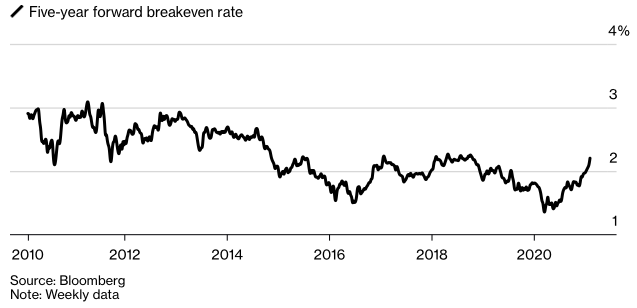The prospect of rising inflation would have been dismissed as sensationalistic journalism just a few months ago. However, with the Federal Reserve keeping interest rates low, increased spending expectations from the new administration and an expected splurge in post-pandemic consumer spending, inflation risks may be on the rise for the first time in a long time.
Let’s take a look at the risk of inflation, how it will impact fixed income investments and how to protect your portfolio over the long term.
Be sure to explore our Fixed Income Channel to learn more about income generating strategies.
Quantifying Inflation Risk
At present, the financial markets predict that U.S. inflation will rise to a little over two percent, but some economists worry that these forecasts are too conservative, even though these figures alone are sharply higher than the much more sanguine forecasts earlier this year. The concern is that a combination of spending and low interest could cause a spike in inflation.

5-Year Forward Breakeven Rate – Source: Bloomberg
The federal deficit hit $3.1 trillion in fiscal 2020 thanks in large part to COVID-19 relief spending measures. In January, the federal deficit reached $165 billion, and it could still rise sharply higher as the Biden administration pushes for a nearly $2 trillion relief package. Meanwhile, the Federal Reserve has committed to keeping interest rates near zero through at least 2023.
Other economists are skeptical that inflation will move beyond two percent – even with high spending and low interest rates. They point to the 2008 financial crisis where inflation fell despite predictions that massive spending could cause a spike. Their rationale is that workers have little bargaining power to push up wages – a key driver of inflationary periods.
Despite predictions by the financial markets, many experts believe that inflation will likely have a muted impact over the next 12 months. In particular, they believe that excess capacity and high unemployment will keep inflation from reaching levels that would result in a change to monetary policy, which could mean that current risks are overblown.
Impact on Fixed Income
Inflation has a negative impact on fixed income assets when it results in higher interest rates. Higher interest rates force bonds to increase yield to remain competitive, which necessarily lowers bond prices. These price changes may not necessarily impact bonds held until maturity, but they do impact many bond funds and create opportunity costs for investors.
In addition to existing bonds, the Department of the Treasury (USDT) is expected to increase bond issuance to finance government spending, which could further depress prices. There is also the possibility that the Federal Reserve will taper its asset purchases earlier than anticipated and steepen the yield curve if the economy reaches full employment faster than anticipated.
Corporate bonds could also be impacted by rising inflation and interest rates. With investment-grade bonds reaching a record 8.5 years duration at the start of 2021, rising interest rates could be especially painful in the corporate bond market, since long-term bonds are more affected by rising inflation than short-term bonds.
Click here to explore the portfolio management channel and learn more about different concepts.
Protecting Your Portfolio
Many economists believe that some inflation is good for an economy since it eases real debt burdens and encourages spending. The problem is that stubbornly high inflation rates can quickly erode savings and investments, creating a need for higher returns in order to maintain purchasing power over a person’s investment time horizon.
There are several ways to protect a portfolio from inflation:
- Reduce cash savings: Most financial advisors recommend having three to six months of expenses in cash as an emergency fund. However, excess cash beyond those levels could become a liability in an inflationary environment, and it’s better invested in financial assets or used to pay down debt.
- Short-term bonds or TIPS: Long-term bonds have the greatest exposure to rising inflation rates. Investors can reduce that risk by moving into shorter-term bonds or inflation-linked bonds, like Treasury Inflation Protected Securities, or TIPS, which automatically adjust for rising inflation rates.
- Invest in hard assets: Real estate and commodities tend to increase in value when inflation rises since their value isn’t tied to currency valuations. In particular, gold is often cited as an alternative asset that moves higher when inflation risks rise.
- Consider alternative assets: Cryptocurrencies, collectibles and other alternative assets may be appealing when equity and fixed income valuations exceed comfortable levels. Of course, cryptocurrencies are known for their significant volatility, and other alternative assets tend to have higher expenses and illiquidity concerns associated with them.
Of course, it’s worth reiterating that inflation expectations don’t always match reality. Many experts believe that the financial market’s concern over inflation is overblown, which could make inflation-linked securities and other inflation-conscious assets overvalued.
Our Best Dividend Stocks List has 20 of the highest-rated stocks by our proprietary Dividend.com Rating system. Go Premium to find out the entire list.
The Bottom Line
The prospect of rising inflation has significantly increased over the past few months with rising government spending and low interest rates. While the financial markets and experts are at odds with the level of risk, there are some steps that investors can take to protect their portfolios and hedge against the possibility of future inflation.
Keep track of the latest news in our News section, where we regularly publish the latest around dividend investing.

